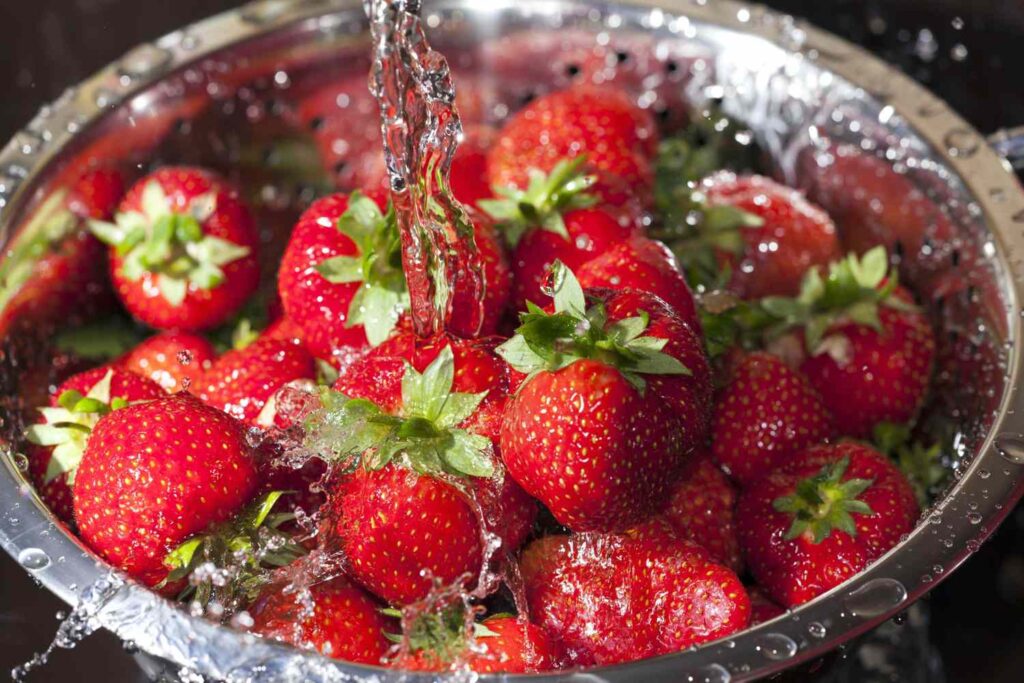How to Clean Strawberries
Strawberries are a delicious and nutritious fruit that are enjoyed by people of all ages. However, before consuming them, it’s important to properly clean and prepare them to remove any dirt, pesticides, or other contaminants. In this comprehensive 5,000-word article, we will explore the best methods for cleaning strawberries, provide tips for storing them, and address frequently asked questions about the process.
The Importance of Cleaning Strawberries
Strawberries are often grown using various pesticides and other chemicals to protect them from pests and diseases. While these substances help ensure a bountiful harvest, they can be harmful to human health if consumed in large quantities. Additionally, strawberries can harbor bacteria and other microorganisms that can cause foodborne illnesses if not properly cleaned and stored.By taking the time to thoroughly clean and prepare strawberries before eating or cooking with them, you can reduce your exposure to potentially harmful substances and ensure that you are consuming a safe and healthy product. This is especially important for young children, pregnant women, and individuals with weakened immune systems, who may be more susceptible to foodborne illnesses.
Methods for Cleaning Strawberries
There are several effective methods for cleaning strawberries, each with its own advantages and disadvantages. Here are some of the most common techniques:
1. Rinsing with Water
The simplest and most straightforward method for cleaning strawberries is to rinse them under cool running water. This helps remove any surface dirt, dust, or debris that may be present on the fruit. To ensure that all areas of the strawberry are thoroughly cleaned, gently rub each berry with your fingers as you rinse it.
2. Soaking in Vinegar Solution
Another effective method for cleaning strawberries is to soak them in a solution of water and white vinegar. This helps to remove any pesticide residues or other contaminants that may be present on the fruit. To make the solution, mix 1 part white vinegar with 3 parts water in a large bowl or container. Submerge the strawberries in the solution and let them soak for 5-10 minutes, then rinse them under cool running water.
3. Using a Produce Wash
There are a variety of commercial produce washes available that are specifically designed to clean fruits and vegetables. These products typically contain a combination of surfactants and antimicrobial agents that help to remove dirt, pesticides, and other contaminants from the surface of the fruit. To use a produce wash, simply follow the instructions on the package, which may involve soaking the strawberries in the solution or spraying them directly.
4. Brushing with a Soft-Bristled Brush
For stubborn dirt or debris that won’t come off with rinsing or soaking, you can use a soft-bristled brush to gently scrub the surface of the strawberries. This helps to dislodge any stuck-on particles and ensures that the fruit is thoroughly cleaned. Be sure to rinse the strawberries under cool running water after brushing to remove any remaining dirt or debris.
5. Removing the Stem and Leaves
One of the most important steps in cleaning strawberries is to remove the stem and leaves before eating or cooking with them. This helps to ensure that any dirt, pesticides, or other contaminants that may have accumulated in these areas are removed. To remove the stem and leaves, simply pinch the green cap at the top of the strawberry and gently pull it off.
Tips for Storing Cleaned Strawberries
Once you have cleaned your strawberries, it’s important to store them properly to ensure that they stay fresh and delicious. Here are some tips for storing cleaned strawberries:
1. Dry the strawberries thoroughly
After cleaning the strawberries, it’s important to dry them thoroughly before storing them. Excess moisture can cause the fruit to spoil more quickly. You can use a clean paper towel or a salad spinner to remove any excess water from the strawberries.
2. Store in an airtight container
Place the dried strawberries in an airtight container or resealable plastic bag. This helps to prevent air from reaching the fruit and causing it to spoil more quickly. Be sure to remove as much air as possible from the container before sealing it.
3. Refrigerate
Store the cleaned and dried strawberries in the refrigerator. The cool temperature helps to slow down the growth of mold and bacteria, which can cause the fruit to spoil. Be sure to consume the strawberries within 3-5 days of storing them in the refrigerator.
4. Avoid washing until ready to use
If you plan to store the strawberries for more than a day or two, it’s best to wait to wash them until you are ready to use them. Washing the strawberries before storing them can cause them to spoil more quickly due to the excess moisture.
5. Freeze for longer storage
If you have a large quantity of strawberries that you won’t be able to consume within a few days, you can freeze them for longer-term storage. To freeze strawberries, wash and dry them thoroughly, then place them in a single layer on a baking sheet. Once frozen, transfer the strawberries to an airtight container or resealable plastic bag and store them in the freezer for up to 12 months.
Frequently Asked Questions
Q: Do I need to wash strawberries if I plan to remove the stem and leaves?
A: Yes, it’s still important to wash strawberries even if you plan to remove the stem and leaves. Dirt, pesticides, and other contaminants can accumulate on the surface of the fruit and may not be completely removed by removing the stem and leaves alone.
Q: Can I use soap or detergent to clean strawberries?
A: It’s generally not recommended to use soap or detergent to clean strawberries, as these substances can leave behind a soapy taste and may be difficult to rinse off completely. Stick to using water, vinegar solutions, or produce washes specifically designed for cleaning fruits and vegetables.
Q: How long do cleaned strawberries last in the refrigerator?
A: Cleaned and dried strawberries will typically last 3-5 days in the refrigerator when stored in an airtight container. For longer storage, you can freeze the strawberries for up to 12 months.
Q: Can I reuse the vinegar solution for cleaning multiple batches of strawberries?
A: No, it’s best to use a fresh vinegar solution for each batch of strawberries you clean. The solution can become contaminated with dirt, pesticides, and other substances from the first batch of strawberries, making it less effective for cleaning subsequent batches.
Q: Do I need to remove the stem and leaves before washing the strawberries?
A: No, you can leave the stem and leaves on the strawberries while washing them. In fact, leaving them on can help protect the fruit from damage during the cleaning process. Just be sure to remove them before eating or cooking with the strawberries.
Q: Can I use a dishwasher to clean strawberries?
A: No, it’s not recommended to use a dishwasher to clean strawberries. The high heat and harsh detergents used in dishwashers can damage the delicate fruit and leave behind a soapy taste. Stick to manual cleaning methods like rinsing, soaking, or using a produce wash.
Q: Do organic strawberries need to be washed?
A: Yes, even organic strawberries should be washed before eating or cooking with them. While organic farming methods may use fewer synthetic pesticides, organic strawberries can still harbor dirt, bacteria, and other contaminants that should be removed before consumption.
Relevant Information in Table Format
| Statistic | Value | Source |
|---|---|---|
| Percentage of Strawberries Contaminated with Pesticides | 90% | Environmental Working Group |
| Number of Foodborne Illnesses Linked to Strawberries | 1,927 | CDC |
| Recommended Vinegar to Water Ratio for Cleaning Strawberries | 1:3 | FDA |
| Average Shelf Life of Cleaned Strawberries in the Refrigerator | 3-5 days | USDA |
| Percentage of Strawberries Grown Using Pesticides | 100% | Environmental Working Group |
Strawberry – Wikipedia. (n.d.). Retrieved from https://en.wikipedia.org/wiki/Strawberry



